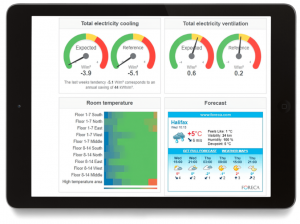There’s free energy to be harnessed from every building. The trick is taking advantage of thermodynamics through artificial intelligence (AI).
It may sound like science fiction at first, but the idea has been around for decades. Since the 1970s, academic researchers have been fine-tuning the process of using a building’s natural thermal mass to influence internal temperatures. And today, one company out of Halifax is bringing the benefits of that research to help building operators achieve more efficient, eco-friendly, and cost-effective HVAC operations in the form of an AI solution.
That company is EcoPilot Canada | USA, a proud “carbon crusader” that uses AI-driven software of the same name to optimize HVAC systems in real-time to deliver the greatest energy efficiency possible.
“Think of it as a brain that can be added to any building automation system to unlock this free energy that’s always been there,” says Jennie King, Commercial Director with the Halifax-based company.
Ecopilot®’s program constantly monitors a building’s static (e.g., thermal mass) and fluid elements, the latter of which include internal heat sources (e.g., people, computers, and lighting) or external weather (e.g., temperatures, wind speed, humidity, solar incident radiation, etc.). Every two minutes, the AI then analyzes these factors along with predictive data (e.g., weather forecasts) to calculate the variable balance point temperature of a building.
 Pinpointing that specific balance point temperature is step one. Next, Ecopilot® shares that number with the building’s existing BMS system, where it is used to align prescribed HVAC set points so that they react with the real-time balance point temperature. Doing so reduces HVAC fluctuations and eliminates unnecessary system overlaps, such as heating and cooling an environment in the same day or at the same time.
Pinpointing that specific balance point temperature is step one. Next, Ecopilot® shares that number with the building’s existing BMS system, where it is used to align prescribed HVAC set points so that they react with the real-time balance point temperature. Doing so reduces HVAC fluctuations and eliminates unnecessary system overlaps, such as heating and cooling an environment in the same day or at the same time.
“Essentially, Ecopilot® uses all this real-time data to continuously re-commission the HVAC system every two minutes,” explains King. “The result is that these systems start running far more efficiently, use less energy, and reduce their carbon emissions – all while keeping people a lot more comfortable.”
Ecopilot® has spent over a decade bringing its AI tech to property stakeholders across Canada and the world. And while King admits there can be some upfront hesitation to bringing AI into building operations, those that make the upgrade are quick to reap the rewards.
In June 2018, for example, Crombie REIT’s Cogswell Tower, a 50-year-old concrete office building in Halifax implemented Ecopilot® to help save energy across its 14-storey, 200,000 sq. ft. asset. Doing so reduced energy costs by 26.5%, generating a return on their investment under two years. Moreover, Pat Poirier, Manager of Engineering and Sustainability, reported they had reduced energy consumption by over one million kWh, exceeding their expectations for their entire campus of buildings.
 More recently, MINTO PROPERTIES implemented the tech at a multi-unit residential property at 150 Roehampton Ave in Toronto. Speaking to early reservations, Joanna Jackson, Director of Sustainability & Innovation at MINTO PROPERTIES, recalls: “We were concerned about not achieving the expected energy savings. However, Ecopilot®’s minimum savings guarantee ensures that the project will be successful from a financial perspective.”Fast forward to now, and Jackson reports that the Ecopilot® system has succeeded in optimizing the building’s operations and reducing its electricity and natural gas consumption, noting, “The system also identifies if the equipment is not operating properly. That allows us to react faster to maintenance issues and improve residence satisfaction by minimizing system down-times.”
More recently, MINTO PROPERTIES implemented the tech at a multi-unit residential property at 150 Roehampton Ave in Toronto. Speaking to early reservations, Joanna Jackson, Director of Sustainability & Innovation at MINTO PROPERTIES, recalls: “We were concerned about not achieving the expected energy savings. However, Ecopilot®’s minimum savings guarantee ensures that the project will be successful from a financial perspective.”Fast forward to now, and Jackson reports that the Ecopilot® system has succeeded in optimizing the building’s operations and reducing its electricity and natural gas consumption, noting, “The system also identifies if the equipment is not operating properly. That allows us to react faster to maintenance issues and improve residence satisfaction by minimizing system down-times.”
 Implementing AI into MINTO’s BAS seemed like a leap at first, she adds, but the outcomes have alleviated any doubt: “As we move towards low-carbon technology and attempting to minimize greenhouse gas emissions, it becomes more important to operate the equipment as efficiently as possible. Smart building technologies bridge the gap between design and actual operating efficiency.”
Implementing AI into MINTO’s BAS seemed like a leap at first, she adds, but the outcomes have alleviated any doubt: “As we move towards low-carbon technology and attempting to minimize greenhouse gas emissions, it becomes more important to operate the equipment as efficiently as possible. Smart building technologies bridge the gap between design and actual operating efficiency.”
Success stories like MINTO’s are adding up. Over its 13-plus years, Ecopilot® has seen its system installed in over 1,200 buildings worldwide, improving building efficiencies by up to 40% annually with a three-year ROI.
AI and smart machines are recoding virtually every facet of property management. Ecopilot® is among the innovations merging established building science with cutting-edge tech to create future-ready assets.






